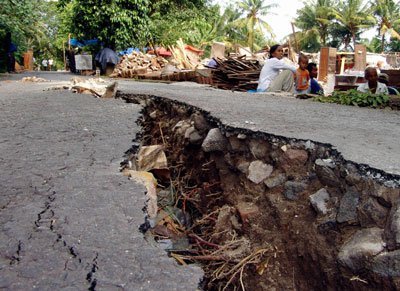The SMC team took a ride out to the GNS Science headquarters at Avalon today for the launch of the Natural Hazards Research Platform.
 Despite the presence of two ministers – Wayne Mapp, in his role as Minister for Research, Science and Technology and David Carter, the Minister for Agriculture, it was a fairly low-key affair. After all, the “platform” isn’t anything in particular to behold – no shiny new scientific instruments or gadget-packed buildings are part of the package. What is new, according to the Government is the funding model for this particular project.
Despite the presence of two ministers – Wayne Mapp, in his role as Minister for Research, Science and Technology and David Carter, the Minister for Agriculture, it was a fairly low-key affair. After all, the “platform” isn’t anything in particular to behold – no shiny new scientific instruments or gadget-packed buildings are part of the package. What is new, according to the Government is the funding model for this particular project.
There’s no press release on the launch today from the main Crown research institute involved, GNS Science, but this release from Dr Mapp’s office has the bulk of the details.
Essentially the Government has committed to putting $140 million into natural hazards research over the next 10 years. The funding will support a partnership between GNS and NIWA, while the venture will “potentially” include the University of Auckland, the University of Canterbury, Massey University and Opus.
What’s relatively unusual is the long-term nature of the funding commitment. Usually, such research, whether carried out by a Crown research institute, a university or a Centre of Research Excellence (CoRE) involves the scientists having to reapply every few years to have the funding extended. Obviously, there’s a limited pot of money and a huge number of worthy research initiatives to fund, so the funding is hotly contested.
This funding commitment however, pretty much guarantees the funding, as long as the outcomes are acceptable. GNS for its part said it is sure of success and welcomes the “scrutiny”.
Whether the funding of the Natural Hazards Research Platform reflects a new approach to funding for science overall may become clear next Wednesday, when Dr Mapp will outline his views on where research, science and technology should be heading in New Zealand.
As for the scientists who will be involved in the research platform, apparently they will include people from a number of disciplines including “hydrology, seismology and climate”.
That suggests that other than the key natural hazards on our radar, such as earthquakes, volcanoes and lahars, the research will cover flooding, tsunamis and the impact of sea level rise due to climate change.
A focus of today’s presentation was the international flavour the research will take – collaboration on a global scale seems to be the name of the game. In the area of natural hazards, that international collaboration is already well under way – as today’s Nature paper involving US scientists looking at earthquakes in New Zealand shows. Hopefully, the funding commitment will lead to more collaboration as natural hazards pose threats to an increasing number of people around the world.